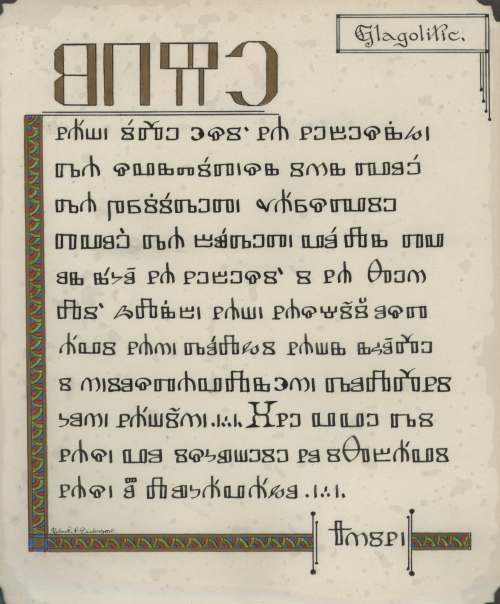 I'm going to come out and admit right now that I'm still trying to wrap my mind around this one, because I'm having a hard time categorizing it in my mind. Leos Janacek's Glagolitic Mass is unlike any mass I've ever heard before: at times, it is melodic, others dissonnant, sometimes like a grand suite, others a tone poem. Whole movements are written without a specific key signature, because the composer modulates so much between them that it wouldn't have mattered -- you definitely won't end up where you started. Add to that the fact that it is sung in Old Church Slavonic (the term "Glagolitic" refers to the Glagolitic alphabet, a written form derived originally from Greek and what would later evolve to become the Cyrillic alphabet used by the modern Slavic and Russian languages), and you have a big, sweeping choral work with some unique challenges. One could describe it as "modern," but that would be too much of a generalization, and some people tend to equate "modern" with "bad," which is certainly not the case here. However, it certainly departs from what journeyman-level listeners of orchestral music might consider "classical," since it is very distinctly 20th Century in sound and orchestration. It challenges the listener to redefine their ideas of what music is supposed to sound like.
It may be instructive to discuss the man before tackling his music. Leos Janacek was born in 1854 in Hukvaldy, Moravia, the son of a schoolmaster. He sang in the boy's choir at the Abbey of St. Thomas in Brno and went on to study music in Prague.
Janacek began his compositional career writing fairly traditional romantic pieces, but as with his contemporaries Angonin Dvorak, Modest Mussorgsky and (later) Bela Bartok, he began to explore other styles that better expressed the message he wished to give to the world. In particular, he began to make use of Moravian and Slovak folk music in his compositions, most notably in his vocal writing. This is considered a major turning point in his career; with the opening of his opera Jenufa in Prague in 1916, he achieved a level of acclaim that was to last for the remainder of his life, and in fact, he is best known today for the music he wrote in this later period of his life.
Much of his music from this later period employs unorthodox spacing and rhythm, and as metnioned earlier, a modality and sort of movement that transitions smoothly yet unexpectedly from theme to theme. As he explained, "...there is no music without key. Atonality abolishes definite key, and thus tonal modulation... Folksong knows of no atonality." (Hollander 1963)
Much of that is evident in his Glagolitic Mass. Written in 1926 toward the end of his life, it follows a fairly standard form for masses of the Orthodox Church tradition, with a few extra ornaments in the form of an instrumental introduction and an organ solo and exodus at the end (Some research indicates that the Intrada (Exodus) was intended to also be played at the beginning to make the piece symmetrical).
I'm going to come out and admit right now that I'm still trying to wrap my mind around this one, because I'm having a hard time categorizing it in my mind. Leos Janacek's Glagolitic Mass is unlike any mass I've ever heard before: at times, it is melodic, others dissonnant, sometimes like a grand suite, others a tone poem. Whole movements are written without a specific key signature, because the composer modulates so much between them that it wouldn't have mattered -- you definitely won't end up where you started. Add to that the fact that it is sung in Old Church Slavonic (the term "Glagolitic" refers to the Glagolitic alphabet, a written form derived originally from Greek and what would later evolve to become the Cyrillic alphabet used by the modern Slavic and Russian languages), and you have a big, sweeping choral work with some unique challenges. One could describe it as "modern," but that would be too much of a generalization, and some people tend to equate "modern" with "bad," which is certainly not the case here. However, it certainly departs from what journeyman-level listeners of orchestral music might consider "classical," since it is very distinctly 20th Century in sound and orchestration. It challenges the listener to redefine their ideas of what music is supposed to sound like.
It may be instructive to discuss the man before tackling his music. Leos Janacek was born in 1854 in Hukvaldy, Moravia, the son of a schoolmaster. He sang in the boy's choir at the Abbey of St. Thomas in Brno and went on to study music in Prague.
Janacek began his compositional career writing fairly traditional romantic pieces, but as with his contemporaries Angonin Dvorak, Modest Mussorgsky and (later) Bela Bartok, he began to explore other styles that better expressed the message he wished to give to the world. In particular, he began to make use of Moravian and Slovak folk music in his compositions, most notably in his vocal writing. This is considered a major turning point in his career; with the opening of his opera Jenufa in Prague in 1916, he achieved a level of acclaim that was to last for the remainder of his life, and in fact, he is best known today for the music he wrote in this later period of his life.
Much of his music from this later period employs unorthodox spacing and rhythm, and as metnioned earlier, a modality and sort of movement that transitions smoothly yet unexpectedly from theme to theme. As he explained, "...there is no music without key. Atonality abolishes definite key, and thus tonal modulation... Folksong knows of no atonality." (Hollander 1963)
Much of that is evident in his Glagolitic Mass. Written in 1926 toward the end of his life, it follows a fairly standard form for masses of the Orthodox Church tradition, with a few extra ornaments in the form of an instrumental introduction and an organ solo and exodus at the end (Some research indicates that the Intrada (Exodus) was intended to also be played at the beginning to make the piece symmetrical).


Updated: June 11, 2007
